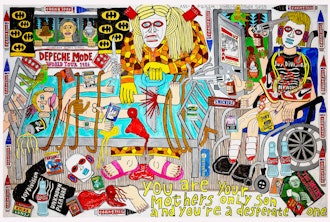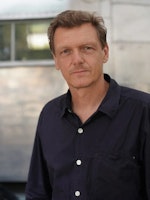Vegard Vinge's and Ida Müller's performances of Ibsen's works resemble a slow motion of understanding. Instead of producing a line version of compact duration, their productions unfold the text in a marathon. Behind each evening of her series of performances of an Ibsen play lie many hours of further scenes, other sets, costumes, films and songs, all rehearsed and prepared within an altogether umpteen times longer work, of which the audience sees differently composed excerpts each evening. Their theatre does all the strokes for this and converts the text into a total work of art that, as installation, performance, film, drawing and sculpture, develops a poetic world that is hermetic in its language but also porous to the mood in the auditorium and the team.
Vinge / Müller's meditations on Ibsen's works pay attention to the smallest asides in his dialogues. Isolated sentences and words in the play are treated by the performers like lines from a poem, repeated over and over again in the performance until they speak for themselves. Every step of the characters on stage, every opening of a door is set to live music and the text does not sound from the characters' mouths but is played as a pre-produced sample. The extreme artificiality of this theatrical world surprisingly creates an encounter with something very real, because what is seen on stage is what it is and has the solid presence of concrete things, bodies, singing, piss, a digger, horse or wood.
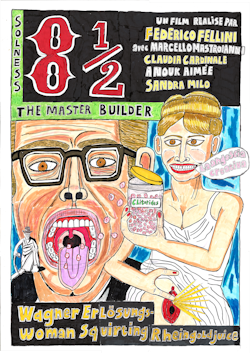
Illustration: Vegard Vinge
Ibsen showed the people on stage with a new realism. The utmost artificiality, his plays show, is on the theatre that which looks like everyday life itself. We still forget this artificiality today when we watch a film. This realism of everyday-looking language and socially familiar situations was Ibsen's way of creating something like reality on stage. Vinge / Müller succeed in doing this in a completely different way. They show the "made" of this world, not in the sense of Brecht, but rather in the sense of an exhibition of pictorial objects that are artificial per se and imitate nothing, but are reminiscent of many things. It is their way of dealing with the as-if of theatre.
Ibsen was a writer of scandal. Each of his plays, which seem photographically direct, is based on the confrontation of the characters and the audience with a shock, which, as in Jon Fosse's plays today, is usually revealed in the pauses between words and sentences. His plays are apparatuses of inevitability that bring to light the violent structures within bourgeois society and show that culture is constantly remaking itself through them. Ibsen showed the presence of a violence that dresses itself in the shape and narratives of the good, the absolute, the beautiful, the truth or success and leads individuals to extreme decisions.
Ibsen, the founder-time author, also sees that this violence is supra-individual, deeply connected to the order of capital, law and gender relations. This subterranean order is given representative faces in the characters of his dramas. His plays are not critical of capitalism in the contemporary sense, but attentive to every form of violence on which culture is based. Supposedly, it is always on the side of humanism, but Ibsen saw it differently.
Culture and art are part of a game through which a society forms a community by creating a consensus about what does not belong to it. Much of our culture is, as the artist and theorist Peter Weibel once called it, a "salon culture" that spares us from looking into the violent processes inside our own culture. The lids of my eyes are usually too closed for this experience. It takes the plays of Ibsen, Jon Fosse or the performances of Vinge / Müller.
Seen through their eyes, the family relationships of the individual plays suddenly reveal a deeper network of types, motifs and conflict mechanisms running through the various plays. Their performances combine these patterns with found images from art history, cinema, the songs of opera and pop music. The artists take Ibsen's dramas completely at their word and transform them into a kind of "platform" in their productions. They insert countless "inserts" into the score of the text, take up motifs from the text such as "betrayal of love" or the "sacrifice of one's own child" and let them sound as opera arias alongside the words or appear in a live film.
It is a theatre of association, association in the sense of a deliberate connection and linking of different artistic forms of expression, in which a concrete observation and feeling, as noted in Ibsen's text, is combined, commented on, refracted with the power of song, image or film in other works.
Why do Vinge/Müller stage only Ibsen?
Why Ibsen? Peter Stein never staged only Botho Strauß, Stanislavski never only Chekhov and Ariane Mnouchkine never only Moliere, why do Vinge/Müller stage only Ibsen? Their Ibsen obsession is unique in the world of theatre. Theatre cannot be more Nordic than in this persistent return to this archetypal theatre of the Norwegian founding era. Ibsen was born in Stockmanngarden in Skien in 1828, in what was then an unborn country that first received its own constitution in union with Sweden only ten years earlier. His plays are closely interwoven with the self-discovery of a nation and therefore still very directly address the struggle for a distinct identity of contemporary Norway.
Like Chekhov, Ibsen looks from the old time at the incursions of modernity into the gardens of tradition and at the careers of the drivers of change. Ibsen's wondering at this founding time of a nation, of the narratives, rules and conventions it produces as a bourgeois society, recreates the theatre performances of Vinge/Müller. The dramas of the ancient Greeks were family plays. And so are those works by Ibsen that are staged by Vinge / Müller. They follow the trail of violence that entered the world of the doers and their children in the name of beauty and goodness, ideals and business, shaping our culture in ways we do not want to acknowledge.
Heinrich von Kleist remarked about the German painter Caspar David Friedrich that he was a man whose eyelids had been cut away. He had to see. This is my image for the work of Ibsen and of Vinge / Müller. It is not Ibsen's idea-driven historical dramas, not "Emperor and Galilean" or "Brandt" that are performed by Vinge / Müller, but the apparent softcore of his family stories that turn out to be hardcore in the eyes of these theatre artists, like the crimes of Anders Breivik or "family history" of the Minister of Justice Tor Mikkel. Go in instead of look - that is what the myth-affine theatre of Vinge / Müller does and at the origin of every myth lies a hidden crime.
Their theatre is not woke, but sensitive to violence. They allow the violence and scandal in the background to re-emerge as a greater doom. Instead of the index finger, their theatre shows the fist. It is not only about exposure, about accusation, but the theatre itself is understood by the artists as a medium of catharsis, fusion and purification and these processes lead through the body and stretched time.
"Go in instead of looking at" was the motto of performance artist Allan Kaprow. His happenings and environments were situational, could not be collected, but gave art history a new perspective in the 1960s. His motto became the most succinct formula for what we describe today as immersive art, as the dissolution of the relationship between work and viewer - something that also characterises Vinge / Müller's theatre, in which the performance does not remain behind the portal and the viewers are an actively perceived part of the play.
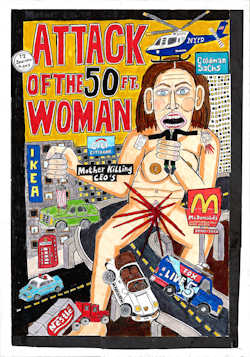
Illustration: Vegard Vinge
While typical directors in repertory theatre usually go home after the premiere and never see their works again, Vinge / Müller are on board their performance ship every evening, continue to rebuild it, change course, play along and direct it live. For more than 20 years, their theatre has not produced products in the sense of completed works, but open processes. Their performances are not piece machines that start moving according to the stage manager's stopwatch and repeat stably from then on, but moving total works of art that reassemble themselves from the pool of their prepared elements in a different selection every evening.
These theatre evenings live, breathe, know moments of perplexity, of stagnation and sudden change into a kind of ecstasy and oblivion of time, in which a kind of communion develops, something common between hall and stage. What sounds fascinating from the theatre-goer's point of view describes, on the other hand, the horror of the classical stage managers, i.e. those "machinists" of the performance business who, invisible to the audience, direct the operations of all the theatre's trades at a console on the side stage, from the stage technology to the performances of the actors and the changes of lighting moods. This exact timing of all processes, laid down in the director's book, does not exist in Vinge / Müller. In addition to the console of the classical stage manager, they set up other consoles in the last row of the auditorium, from whose controllers and computers the production is navigated and changed live. Nothing is repeated in their theatre. The set-up of this living apparatus is the basis of her work.
Here, the theatre becomes a giant playstation - the crew of specialists at the back of the audience constantly changes the mixing ratio of light, sound or videos, the sequence of the scene and reacts flexibly and experimentally to the mood of the hall and team, so that the individual performances in the Vinge / Müller theatre are as unique as a DJ set in Berlin's Berghain. This theatre does not want to repeat itself every evening and wants to retain the freedom to be risky, to set new accents, to follow a different path in Ibsen's play and to react to its own experiences in the play as much as to the mood in the hall. There is, to my knowledge, no comparable infrastructure of theatre that delimits the usual system of reproduction in theatre in the same way as Vinge/Müller's way of working. Theatre is always live, but here it is "live live".
Theatre is always live, but here it is "live live".
Installing this "Vinge/Müller console", which is needed to produce this presence and always other evenings, within a repertory theatre has an impact on the whole system - the work of the technicians, the schedulers and workshops and also the artists themselves. This process is a great challenge, but keeping this risk present on stage, not following a routine but organising in the moment, gives her theatre a presence rarely experienced elsewhere. Their way of playing fundamentally unlocks the culture of production and the experience of theatre.
In this machine, Ibsen's literature is transformed into a different code that also contains the iconography of pop modernism, its cinema heroes, auteur artists and rebels, which Vegard Vinge assembles as drawings into his own pantheon. Everything that comes from "outside", from literature or art history, is fitted into this Vinge / Müller code by this copying by hand. The design of the bodies, decors or animated films and drawings shows that everything in the scenery has been de-naturalised, painted, carpentered, filmed and sampled by hand. The theatre imitates nothing here, but creates artificial objects, masks, sounds and images that form an aesthetically closed cosmos. It's a bit like puppet theatre, only bigger, darker, funnier.
It's a bit like puppet theatre, only bigger, darker, funnier.
The enormous power and also delicacy with which Vinge / Müller design their own cosmos and animate it down to the smallest detail is something I know from no other theatre process. For the audience, understanding also includes not understanding, a looking at the stage that has to orientate itself in almost every second, learning to pay attention to signs and to trust poetry. Almost everything in this theatre is an allusion to something I can discover on her stage, in individual words, in emerging quotations from operas or films. Everything it takes to understand is there, but wants to be discovered, by people who see what is really there and forget for moments what they expect. This theatre is not afraid. It thinks we in the auditorium are of age. When its Ibsen console starts playing the play, linking a complex regime of recordings, images and videos to Ibsen's score, behind every quest here lie ten more quests from the world of Solness.
They need their own theatre playstation to be able to play their Ibsen programme. It cannot be loaded onto any other theatre machine. And that's why this other system of performance and related infrastructure is a great challenge. I have never met the artist and artistic director of "Det Norske Teatret" Erik Ulfsby, and yet I can judge from my own experience how strenuous it is for his company to install this Vinge / Müller console in his house.
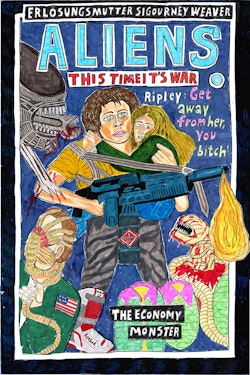
Illustration: Vegard Vinge
A repertory theatre is based on a completely different system of play, logistically, but also mentally. Here, the production follows plannable rules, deadlines and norms. All this confuses this artistic duo and their family and confronts the system in which their Playstation suddenly takes off with deeper questions: What justifies the effort? What are we doing this for? Who is thanking us? Where are our professional standards? Who is paying attention to boundaries? The questions that arise in the encounter with a form of work that does not correspond to the form of one's own operation really lead deep and are valuable.
On my last visit to a Vinge / Müller performance at Det Norske Teatret, I spoke to a young ticket seller who didn't know exactly when the performance would end and when there would be an intermission, but he attended every night and thought it was the greatest thing he had seen in theatre so far. In the end, it must be the love of art itself that makes such productions possible. In their encounter with the different kind of professionalism of regular theatre, Vinge / Müller therefore unspokenly raise the question of the actual profession of those who work in the theatre and thus refer to the theatre's mandate to profess itself loudly and publicly.
In German theatre history, their work at the Berliner Volksbühne and their co-production with the Berliner Festspiele marks a chapter of its own. In his 26-year era as artistic director at the Volksbühne, director Frank Castorf organised the technical running of the theatre in such a way that it could adapt to the artistic needs of the productions instead of ensuring that artistic production had to subordinate itself to the theatre's operating system. Vinge / Müller were attracted to this unique system and the radical play culture of the Volksbühne in East Berlin at the time early on, and they put a lot of strain on it later on. And when Frank Castorf was asked at his farewell as artistic director who he wished a future at this theatre, he named Vinge / Müller. Just as many other Berliners wished. Each of the Berlin productions was invited to the "Theatertreffen" - not that this was an objective proof of quality, but one of effect.
"Let the play be the sling" was handwritten and glowing above the portal of their "Nationaltheater Reinickendorf" in Berlin. This sentence from Shakespeare's Hamlet describes the immediate effect, and above all that it is made for - to lift the masks, to show the truth, reality instead of realism and not to make peace with the Assessor Bracks. It is people like Erik Ulfsby who have created a team and an atmosphere at a house that is receptive to this alien invasion. It is the particular form of their artistic practice that unlocks and challenges the reliable to make this cathartic theatre possible.
In the end, it must be the love of art itself that makes such productions possible.
What theatre always desires - to find an appropriate language for a changing culture - is fulfilled differently than expected in Vinge / Müller's theatre: as much as times change, the subterranean production of violence in our culture remains palpable through the changing times and protagonists. And that is why Ibsen was so interested in the normality of bourgeois society, its everyday family life, its professional life, its ideas.
While all Ibsen performances convey a picture of this, only a few theatre performances go beyond the fresh interpretation in each case and change the process of theatre-making itself. Vinge / Müller's theatre technology is that of the digital age, of feedback, of the permanent availability of information and material that can be freely used at any time. They do not transform the physical objects into digital data, but they do transform them into the aesthetic code of their artistic world, whereby everything here can be connected to everything else. This "updating" affects the operating system and the form of experience of the theatre itself, which is why their performances remain such an exception to this day.
Just as Ibsen injected his psychorealistic theatre into the world of verse dramas and proposed a different language to make the play a sling again, Vinge / Müller's theatre is also a provocation and form renewal. And great fun that releases thought. Vinge / Müller also see with eyes wide shut. Toi toi toi.
